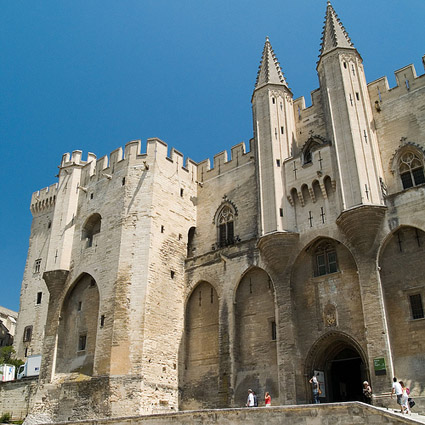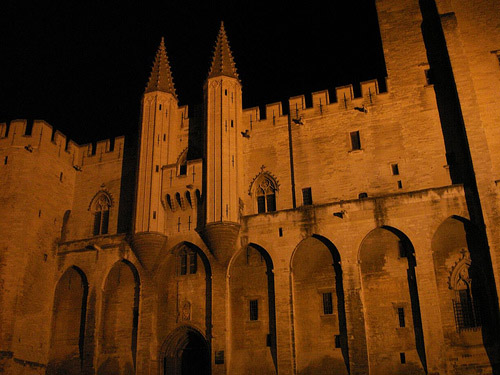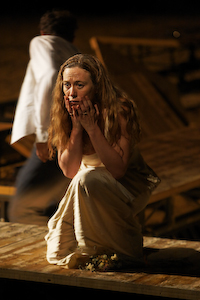
Photo by Etienne Boucher
Let us pray. Now that we’ve done that, welcome to the Palace of the Popes!
It was once the mighty symbol of the church’s influence throughout the western world.
Today, the Pope’s Palace has welcomed more than 650,000 visitors and is one of the most visited monuments in the entire country.
It is also one of the largest and most important medieval Gothic buildings in Europe.
When to Go
Whenever the urge strikes you! The Popes’ Palace is open every day of the year. Yep, even holidays!
It opens everyday at 9:00 am from March through October. Closing times vary. In March, the palace is open until 6:30 pm. From April 1 through June 30, and September 1 through November 1, the palace is open until 7:00 pm.
The palace is open until 8:00 pm for the entire month of July, and during the entire month of August the palace is open until 9:00 pm.
During the winter months (November 2 through February 29) the palace is open from 9:30 am to 5:45 pm.
The last tickets are sold one hour before closing time.
Cost
Entrance to the papal palace is €10.50.
History of the Palace of the Popes
- The Papal Palace was built at the northern edge of Avignon, overlooking the Rhône River.
- Reconstruction of an old bishop’s palace was begun my Pope Benedict XII in 1335, and was continued by his successors until 1364. The building was extremely expensive, consuming a good portion of the papacy’s income during its construction, and by the time it was completed, it occupied an area of 2.6 acres.
- The palace was built in two principal phases with two distinct segments, known as the “Old Palace” and the “New Palace”.
- The Old Palace was constructed at the instruction of Pope Benedict XII, by the architect Pierre Poisson. The sober Benedict had the palace built with four wings flanked by high towers – heavily fortified against attackers.
- The “New Palace” was built under Popes Clement VI, Innocent VI, and Urban V. Clement VI had a new tower and adjoining buildings constructed, as well as a Grand Chapel to serve as the location for papal acts of worship. Two more towers were built under Innocent VI, while Urban V completed the main courtyard.
- The popes departed Avignon in 1377, but this prompted the papal schism in which the antipopes Clement VII and Benedict XIII remained in Avignon until 1408. The building remained in the hands of antipapal forces for some time, but was returned to papal authority in 1433.
- The palace remained under papal control for over 350 afterwards, but gradually deteriorated, despite the restoration in 1516.
- The Papal palace was seized when the French Revolution broke out in 1789. In 1791, it became the scene of a massacre of counter-revolutionaries.
- During Napoleon’s reign, the palace was taken over by the government for use as a military barracks and prison. The building was further damaged, and has been under constant renovation since it was vacated in 1906, becoming a national museum.
- The Palace of the Popes is now one of the famous French monuments most visited by tourists.

What to See
- The frescoes and interior decorations
- The cultural activities

© Avignon Theather Festival
Before the Papal Palace was destroyed by the Revolution, it featured wonderful frescoes and luxurious décor. After Matteo Giovannetti decorated the Stag Room, Clement VI chose him to decorate the rest of the Old Palace. His frescoes that are still intact are one of the most interesting features of the palace, and represent some of the most artistic talent in Avignon.
Early on, the palace was decorated with frescoes, tapestries, paintings, sculptures, and gorgeous wooden ceilings. Today, renovation continues in an effort to restore the palace to what it once was, and these items are being replaced bit by bit.
The Palace of the Popes features many cultural activities throughout the year, and you’re sure to find something of interest. The summer months are the most popular time to visit, as there is something going on every night.
During the month of August, there are classical music concerts three days a week (Wednesdays, Fridays, and Sundays), with the help of the association “Musique Concertante”. The evening is made even more complete with accompanying Côtes du Rhône wines tasting. It is a great way to discover Avignon’s cultural traditions.
Ever since the palace displayed an unforgettable exhibition devoted to Picasso in 1947, art has become a tradition in the Papal Palace. The palace hosts summer art exhibitions every year, displaying major, internationally-renowned art. Check it out!
During the month of July in the courtyard of the Palace of the Popes, is the annual Avignon Theater Festival. All I can say is – you should go!
For over 50 years, the courtyard has served as an open-air theater, and the festival features both unknown works and contemporary plays. Don’t miss it! Find out more about the Avignon Theater Festival.